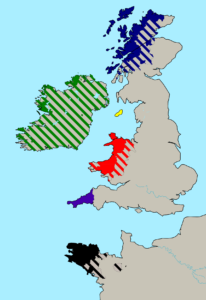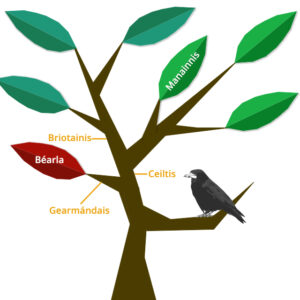Lost and saved
Read the passage on the word ceol and look at the different images of lyres or harps in Images. Then conduct a Snowballing exercise to think about the following questions. Having written down their suggestions individually, pupils should merge into a group of two, then four, then eight, and so on, until a whole-class position is reached. Groups will need to select a time-keeper, a scribe and a spokesperson.
- Why have the images of musical instruments on crosses and shrines survived while the instruments themselves (which were probably mainly made of wood) have not?
- How were tunes passed on before musicians began to write them down?
- What are the main technological advances which enable us to record music today?

Celtic languages
In Modern Irish, cruit can mean ‘a hump’ as well as ‘a small harp’. Welsh has crwth for both ‘a hump’ and ‘a stringed-instrument’. Some Irish and Welsh words are similar because Irish and Welsh are both Celtic languages. Examples of related words are:
| Irish | Welsh | English |
| bliain | blwyddyn | year |
| broc | broch | badger |
| sean | hen | old |
Sometimes, where an Irish word has the letter c, the corresponding word in Welsh has p or b:
| Irish | Welsh | English |
| ceann | pen | head |
| mac | mab | son |
| ceathair | pedwar | four |
Irish is more closely related, however, to Scottish Gaelic and Manx. These are called Goidelic languages. Welsh is more closely related to Breton and Cornish. These are called Brittonic languages.
| Irish | Sc. Gaelic | Manx | Welsh | Breton | Cornish |
| bliain | bliadhna | blein | blwyddyn | bloaz | bledhen |
| broc | broc | brock | broch | broc’h | brogh |
| sean | sean | shenn | hen | hen | hen |
| ceann | ceann | kione | pen | penn | penn |
| mac | mac | mac | mab | mab | mab |
| ceathair | ceithir | kiare | pedwar | peder | peder |
Scottish Gaelic survives in areas of Scotland, Manx is still in use in the Isle of Man, Breton is spoken in Brittany in Northern France, and Cornish is associated with Cornwall in the South-West of England.
The map below shows where Celtic languages are used today. Download and label this map with the names of geographical areas and their associated languages.
Map of the distribution of the Celtic languages. Image © Shikku27316, CC BY-SA 1.0.

Download and complete the language tree.


The power of memory
Make up a song or a short story. Record it on a phone and set this aside for later. Then pass the song or story around the class, one person telling it to another in private. Record the final version and listen to it alongside the original recording. Has the song or story been passed on accurately? What has changed and why?



 back to ceol
back to ceol